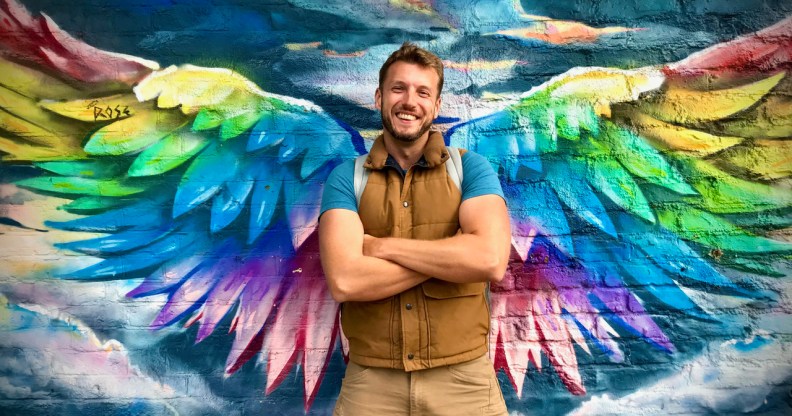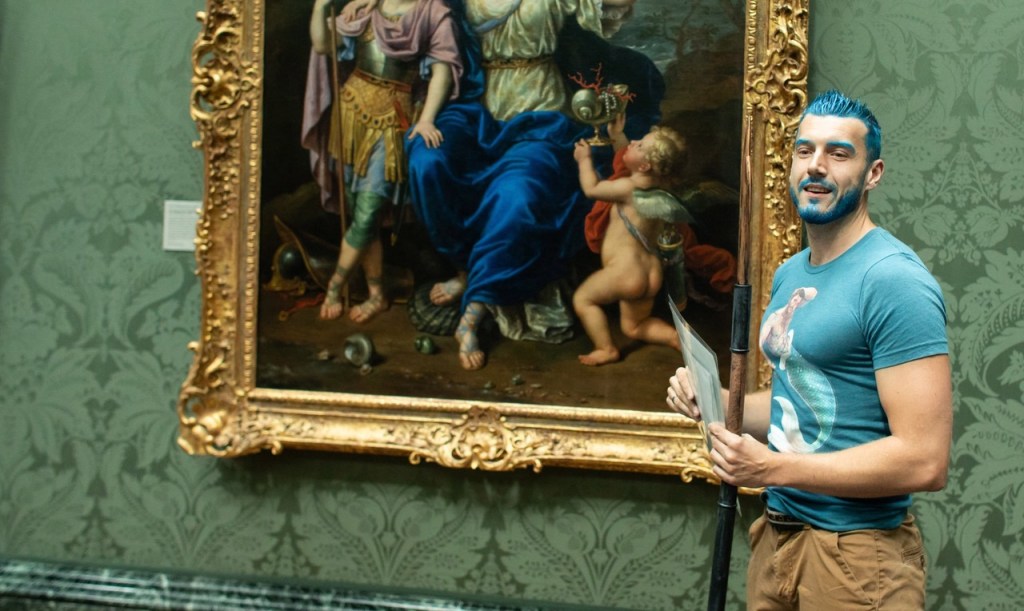Why do so many queer people love myths and legends?

Sacha Coward, author of Queer As Folklore, reflects on why mythology resonates with LGBTQ+ people. (Provided)
Queer as Folklore is an exploration of why the LGBTQ+ community feels such an affinity to mythology. But, as author Sacha Coward exclusively tells PinkNews, it’s not all sparkles and unicorns.
“Were you obsessed with Greek myths? Or were you heterosexual?” Sacha Coward asks PinkNews, parroting a popular Twitter meme, one that forms the basis of Queer as Folklore, which is the historian’s “hidden queer history of myth and folklore.”
Answering why (and how) this bond between the LGBTQ+ community and various global mythologies has persisted over millennia, is the book’s core mission – a crowdfunded, ‘radically inclusive celebration of the untold queer histories within myth and folklore’ that is currently due for a UK August 22 release date.
“If you go to a Pride parade, you will see rainbow flags,” the author and historian says, before adding, “but you will also see mermaids and unicorns, you will see fairy wings, you will see cat ears, and you will see all of the ‘stuff’ that we just see as part of the modern queer experience.
“But where does that come from?” he continues, a question that few e have probably stopped to consider while spray-painting mermaid scales on to a bare chest before a night out. “And is there a more interesting, deeper and possibly an ancient history that connects this almost frivolous aesthetic of queerness?”
These unexplored connections exist for many in the LGBTQ+ community – there’s a reason that one of the UK’s most prominent trans charities is called Mermaids UK, after all – but they often run deeper than the superficial selling points, though Coward does concede that, “yes, there are the hunky men in togas, the fact that unicorns are sparkly and the fact that fairies are fabulous.”
Queer as Folklore explores the “weird resonance,” of queer people simply wanting to see something of themselves reflected in history, having been erased from so much of it.
“People have been fascinated in the history of [those] like themselves, since the dawn of time… not just the history of real people and real things, but the history of the stories we tell,” Coward says. “I think In many ways, the mythical creatures and legends inform who we are, every bit as much as stories of real living people.”
Queer as Folklore traces that comparison, and why “we see ourselves as in these creatures that aren’t fully realised, that are part of a day dream”, the author continues. “There’s a reason why we cover ourselves in unicorn tattoos and sparkly scales and glittery horns. That is part of our story.”
Queer people often look back in time for validation that other such people have always existed, long before them. While Coward is keen to bring to light these “universal and powerful and relatable” figures, he’s also keen to highlight the danger in simply transposing modern terminology across time.
He explains this using the example of the priestesses of Assyrian goddess Atargatis – who were assigned male at birth but would then self-castrate and live as women. As he warns, though, “You wouldn’t necessarily say [they] were ‘trans’, because that specific identity, the exact concept of what we would call transgender today, linguistically only comes into play in the early 20th century.
“That is not to say these priestesses wouldn’t identify with contemporary concepts of trans experience, but we simply cannot say – and language does profoundly shape our understanding of self.”
Aside from self-professed worries that the decision will help the author live up to his last name, Coward also tells PinkNews why it’s important to distinguish the concepts of the past with the vitriolic present.
“I’m trying as hard as possible to write this as if the culture war is not happening. Because I don’t want to be influenced or frightened of what angry people are saying on Twitter [now X]. I also don’t want to write about something that is going to change so quickly, our understanding of sex, gender and history, the words we use, have constantly been in flux, so pandering to online discourse would only get in the way.”
That isn’t to say that queer individuals shouldn’t find power in the references explored. “The idea of people whose gender identity and expression shifts and changes and is not that which they are ascribed at birth is universal, that’s not up for debate,” he continues.
“That experience is something you can see in people all over the world throughout history and time. I’m not
necessarily going to stick a ‘trans’ label on them, just as I wouldn’t use labels like ‘gay’, ‘straight’ or ‘queer’ without context, but I understand that the trans community and non-binary people will hopefully see something powerful in these stories which resonate all the same.“

As Coward mentions, the study of LGBTQ+ history is not always an easy pursuit. Aside from “cisgender and heterosexual historians need[ing] to understand the power of seeing [one]self in the human story,” the history itself is often “fighting” to stay hidden, or doesn’t make for pleasant research.
“If I’m looking for queer history, prior to the 1970s, I’m searching through slurs on public records, because that’s how we were termed. I’m looking into criminal records of sodomy. I’m looking into insane asylums, I’m looking at really hard to read stuff; people being murdered and arrested and killed and vilified.”
Queer as Folklore also aims to combat the idea that if you’re looking into LGBTQ+ history, you’re being “revisionist”, Coward explains. “The presumption being… you’re trying to rewrite it [for] your own nefarious goals, you’re putting yourself and your people like you in a place they don’t belong, which is bollocks because we’ve existed since the dawn of time”.
For Coward, the project is a not only a very sparkly middle finger to those claims, but also an assurance to his younger self, and those like him.
“I feel I’m talking to the younger version of myself, the teenager who walked through the British Museum as a massive Greek myth nerd. As I was slowly coming to terms with my sexuality, I was looking at all these white marble sculptures and these paintings, and in the back of my mind, I was taking on this very toxic message: ‘I don’t see anyone like me, therefore I am an aberration, a strange thing, something new, like a weird, sparkly thing that no one quite knows what to do with’.”
Although Coward notes that he is “standing on the shoulders of giants, because a lot of different people feel a real ownership of these childhood creatures,” the new work is also a celebration.
“The real meaning of this book is not to push an agenda. It is not to try to force history in a different direction. It is not to change history and create some sort of evil dark homosexual cabal.
“It is to look at something that has been looked at many times before, and cast a different light on it, see what happens and where that takes us. For some people, that will be fascinating – and maybe even empowering.”
Queer as Folklore by Sacha Coward will be published on 22 August.

